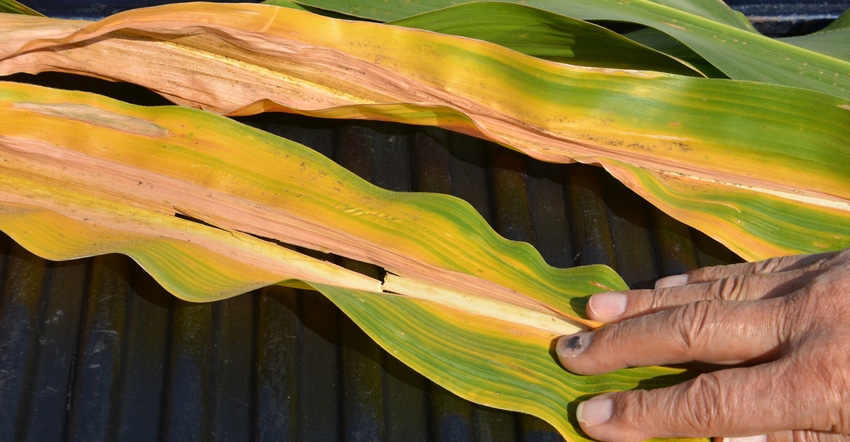
Finding classic symptoms of nutrient deficiencies and diseases on ear leaves very late in the season, near black layer, isn’t unusual. Dave Nanda says plants have used as many nutrients as possible to make kernels as full as possible at this point. Sometimes nutrients are even diverted from leaves to kernels as plants put on the finishing touches before the black layer forms at the tip of the kernel, signaling physiological maturity and preventing materials from entering or leaving kernels.
“Remember that the corn plant’s goal is to produce as many viable progenies as possible,” says Nanda, director of genetics for Seed Genetics-Direct, Jeffersonville, Ohio. Seed Genetics-Direct sponsors Corn Watch ’19.
“Corn plants don’t care how much yield you get,” Nanda says. “They believe they’re producing seed for next season, and they want to produce as many good seeds as possible. It just so happens that the more seeds which are produced, the higher the yield.”
Since plant leaves tend to run low on nutrients at or near black layer, it’s a good time to see classic symptoms of deficiencies, Nanda says. If diseases are present, they’re also likely to show up on leaves at the end of the year. Even if fungicides were applied around tasseling, as they were in the Crop Watch ’19 field, you will still likely find at least some disease lesions.
Here are symptoms found on the leaves pictured above:
Nitrogen deficiency. The symptoms on the bottom two leaves are classic. Also called “firing,” yellowing starts at the tip of the leaf, moves in toward the center along the midrib, and expands across the leaf. Eventually, necrosis, or dying of leaf tissue, occurs. If you want corn to dry down late in the year, like many people did this year, deficiencies and diseases that cause leaves to turn brown and dry up may speed up drydown, assuming kernels reach black layer properly.
Sulfur deficiency. Striping toward the base of the two lower leaves indicates that these plants may have been running low on sulfur, which is no longer a free nutrient supplied in the air in abundant amounts. Plants can show sulfur deficiency occasionally. Interveinal yellowing and leaf striping can be signs of this deficiency.
Potash deficiency. Note the edges of the middle ear leaf in the picture. They’re showing a tinge of yellow discoloration. When potassium deficiency symptoms appear in corn, they usually show up as yellowing along the outside margins of leaf edges. If the deficiency is severe enough or goes on long enough, leaf tissue may turn brown and die.
Gray leaf spot. A couple of lesions are showing on the bottom of the top leaf, just visible in the upper part of the photo. Gray leaf spot is among the most common foliar diseases that affect corn during the growing season.
About the Author(s)
You May Also Like




